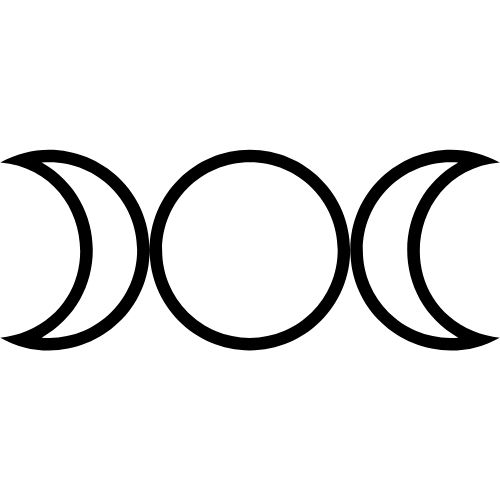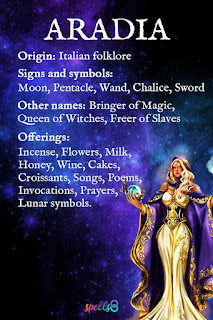Aradia is a folkloric figure as cryptic as she is captivating. The daughter of the Roman goddess Diana, Aradia represents equality, liberation, and independence – and celebrates witchcraft as a form of rebellion.
Born as a response to Roman Catholicism’s persecution of pagans and all who opposed it, Aradia stands tall for witches, slaves, and outcasts. She was sent to liberate the oppressed and teach the craft to witches to empower and enable them in times of desperation.
Aradia is the answer to a call for help from the lost souls that Christianity failed to acknowledge.
Who is Aradia?
Aradia is a triple moon goddess who teaches her followers how to forge their own paths. She is a champion of the oppressed, a heretic goddess, and a Queen of Fairies.
Aradia’s birth coincides with the sacred day of Diana, transpiring on August 13, 1313. Based on certain accounts, she is regarded as the very first witch, compelled by Diana herself to impart her wisdom during mankind’s adversities.
According to the highly-disputed Aradia, or the Gospel of the Witches, she is the daughter of the goddess Diana and her brother, Lucifer. Aradia, emanating from this union of darkness and light, furnished the oppressed with the means to challenge and overcome the religious conflicts plaguing their lives.
Followed by worshipers of the goddess Diana, the enigmatic Aradia plays an integral role in Wiccan history and tradition. Her presence has ignited a renaissance in the practice of conventional Italian witchcraft.
Working with Aradia
The most effective way to connect with the goddess Aradia is by studying Her mythology, epithets, and symbols. Let’s delve into the myths that celebrate and highlight the goddess before sharing some tips on how to honor Her in your rituals.
Myth of Aradia
Lending to her mysterious nature, Aradia’s mythology is conflicted. Whether based on a real historical figure or a goddess born when pagans cried out for a messiah, the goddess Aradia invokes an undeniably strong archetype that is worshiped to this day.
Aradia, Gospel of The Witches
Perhaps the most notable mention of the goddess is Aradia, or the Gospel of the Witches by Charles Godfrey Leland in 1899. This work captures the magic of traditional Italian witchcraft as influenced by the politics of Roman Catholicism and is said to contain knowledge passed down from hereditary witches of Tuscany and Romagna.
Aradia speaks of the goddess Diana lying with her brother Lucifer to conceive a daughter. Aradia is then sent to Earth to teach witchcraft to the oppressed and help them reclaim their power.
While this book is considered a controversial source on the subject due to its contested references, there are many gods with conflicting mythologies. If a modern association is vastly accepted by practitioners, does that not grant power to it?
Aradia di Toscano
If the former version of Aradia’s story doesn’t ring true to you, you’re not alone. Many anthropologists believe The Gospel presents a Christianized deification of a real historical figure.
Born in the year 1313, Aradia di Toscano was the esteemed leader of a Dianic cult that played a pivotal role in the revival of Stregheria during the 14th century. As a testament to its enduring impact, her teachings still hold sway over contemporary Wiccan practitioners.
Herodias
Aradia is thought to be referenced in the Malleus Maleficarum, also known as The Hammer of Witches, where she is identified as Diana’s daughter Herodias. She is described as a sovereign witch, summoning sorcerers to conspire with her under the night’s guise.
This particular text infamously serves as a witch-hunting guide dating as far back as 1486. Its contents were frequently employed to educate individuals involved in witch trials and subsequently prosecute women for over three centuries.
In the Malleus, Herodias is often mentioned alongside Diana, riding with witches on all manner of beasts in their nightly processions to consort with the devil or perform other unholy rituals.
Symbols of Aradia
Aradia is commonly associated with the Pentacle, Wand, Chalice, and Sword featured in traditional Tarot decks.
Pentacle: The pentacle is a powerful tool for grounding energy, manifesting intentions, and invoking spiritual protection. It’s often used in ritual work to harness the energies of the natural world and the Elements.
![]()
Wand: The wand is a symbol of power, transformation, and the ability to channel energy. It’s associated with the element of Fire and represents the practitioner’s ability to shape and influence the energies around them.

Chalice: The chalice is a symbol of the divine feminine, receptivity, and the element of Water. It represents the womb, intuition, and the nurturing aspects of the goddess. In Aradia’s context, the chalice is used in rituals for communion, blessing, and honoring the cycles of life.

Sword: The sword is a symbol of intellect, discernment, and the element of air. It represents the power of clear thought, communication, and the ability to cut through illusions. The sword is used for protection, cutting ties with negative influences, and asserting one’s will in a focused and deliberate manner.

The Triple Moon is commonly associated with the goddess Aradia, and it is a powerful representation of the cycles of the moon, which in turn are often associated with the cycles of life, death, and rebirth. This symbol consists of a full moon and two crescents, each a different lunar phase.

Epithets and Names of Aradia
Below is a short list of names and titles frequently attributed to Aradia: Bringer of Magic
Champion of the Oppressed
Daughter of Diana
Freer of Slaves
Great Goddess
Goddess of the Moon
Holy Strega
Keeper of Secrets
Messiah of Witches
Mistress of the Night
Mistress of the Worlds
Mother of Witches
My Lady Moon
Queen of the Fairies
Queen of Witches
How to Worship Aradia
There are many thoughtful ways to worship the goddess Aradia. Here are a few to get you started: Always remember to cleanse yourself thoroughly before approaching the goddess for rituals.
Learn about the phases of the moon and how to incorporate them into your practice
Make offerings to Aradia at the Full Moon.
Perform the sacred Tragenda sabbat at the Full Moon. (A meal offering comparable to Hekate’s Deipnon.)
Honor Aradia on August 13: Diana’s sacred day and Aradia’s birthday.
Practice rituals skyclad (in the nude) to express your liberation
Invoke Aradia against oppressors and fascists
Practice intersectional feminism and stand up for all walks of life – particularly minorities, women, and all those who have experienced oppression.
Correspondences and Offerings to Aradia Aradia’s Associations: Witchcraft, justice, rebellion, and equality. She is a patron of witches, slaves, outcasts, and all who are persecuted.
Symbols: Crescent moon, full moon, cypress tree
Animals: Deer
Gems: Moonstone, pearl.
Colors: Black, white.
Plants: Anise, belladonna, lemon, jasmine, rue, and vervain.
Genealogy: Daughter of Diana and Lucifer in Gospel of the Witches.
Aradia Offerings
Once you’ve created your altar, you may leave offerings on it for the goddess Aradia. In Roman tradition, leaving a meal offering on a plate for Aradia is an accepted practice, which can later be consumed by yourself once the offering ritual is finished. Here are a few suggestions for common offerings: Incense
Flowers, especially those that bloom at night
Milk
Honey
Wine
Cakes
Croissants
Anything that has a modern association with the moon
Writing songs, poems, invocations, and prayers
Creating an Altar for Aradia
Crafting an altar for the goddess Aradia is a great way to establish a profound connection with her.
Your altar might include black and white candles, crystals, tarot cards, offerings to Aradia, or even the tools you use in your practice.
You can decorate further with a depiction of Aradia or include some triple moon imagery somewhere on your altar.
All hail Aradia, Queen of the Witches
Freer of slaves and glorifier of the oppressed
Pillar of strength, born of light and darkness
All hail Aradia!
May your flame illuminate the way.
If you have read this far, perhaps it’s because you’ve felt a certain calling. The goddess Aradia holds the key to unlocking the latent power dwelling within you. A choice lies before you. Will you learn to empower yourself and others in her name?







.jpg)



0 Comments